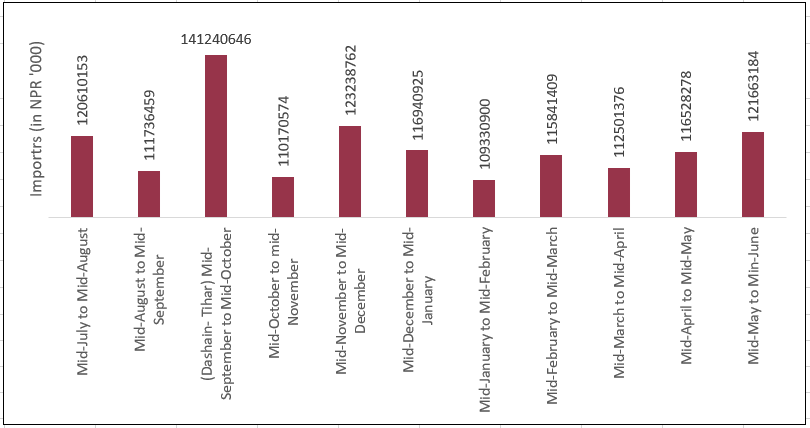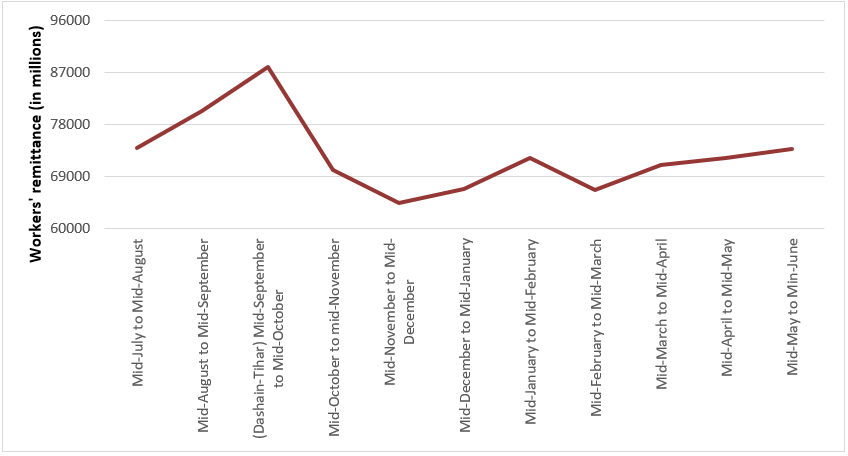An increase in demand for goods and services during festivals does stimulate the economy.
During the Shah-Rana Administration when most people lived in absolute poverty, Dashain-Tihar used to be the only time people could afford to eat meat and buy new clothes. Our per capita income since then has increased tremendously and in this age of consumerism, we don’t wait once a year to celebrate, feast and shop. Nevertheless, our spending capacity increases during the festive season with the head of households giving money to family members to spend, formal employees receiving their bonus, farmers reaping their harvest, workers abroad sending remittances which peak during this time, and consumers generally having a higher propensity to consume. Our consumption rises, not just for livestock and food grain but also for expensive durables and goods that are heavily imported. Surely, this translates to higher sales for businesses and an overall increase in economic activities, but the question is do we utilize our festivals to push the economy in the long run.
Higher Remittance
Studies in Nepal have repeatedly shown that at the micro-level, remittance money is used mainly for consumption and repaying debts, not for investments. During last year, workers’ remittances from mid-September to mid-October reached a record high of NPR 87.9 billion. This increase in money remitted during the festive season can be seen as an outcome of increased demand and consumption of the household. Remittance has helped reduce poverty and stabilize the balance of payment; however, the reality is unless households use it to generate income and purchase domestically produced goods, the money that flowed in will flow out. Without productive investments, more jobs will not be generated and without savings, banks will not have money to lend to businesses. This means our economy will continuously rely on migrant workers who face their share of hardships to earn money.
Influx of Imports
About 25,000 goats are supplied to Kathmandu Valley through domestic production during the festive season but approximately 50,000 more are imported every year to meet the demand. Likewise, domestic supply has not been able to meet the demand for various other goods which is ultimately met through supply from foreign traders. According to foreign trade statistics of 2018, last year during the month of Dashain-Tihar, imports reached a record high of NPR 141 billion. Likewise, compared to the previous month, there was a 109.5%, 145.9%, 284%, and 243.63% increase in imports of livestock, fruits/nuts, knitted or crocheted apparel/clothing accessories, and footwear respectively during the festive season. Nepal had also imported decorative lights worth NPR 600 million for Tihar. Furthermore, the depreciation of Nepalese Rupees has caused a sore in our already massive trade. This surge of imports will hence compound the credit crisis again resulting in difficulty to lend to banks, delayed projects, and an overall weakening economy.
Internal Inefficiencies
Besides the increase in imports, the shortage in domestic supply of goods and services during the festive season has created various internal issues as well. Long queues to book public bus tickets has always caused hassles for the general public. Limited transportation facilities for approximately 2.5 million people leaving Kathmandu valley means that there is cramming and overloading, making vehicles prone to accidents. Since the government has mandated quarantine and health examinations for goats, traders especially from India who do not have the required documents illegally supply them to Nepal. If all domestic goats are sold during the festive season, traders fear that there will be a huge shortage afterward. Moreover, Nepal Rastra Bank has incurred a cost of approximately NPR 63 crore to print new notes which is again uneconomical since new notes have a reduced life span due to the damages caused by the acidic nature of color.
Increase in Credit and Societal Pressure
People with financial difficulties who do not have money to spend tend to borrow for festivals but are unable to pay it, which has resulted in mounting debt. Societal pressure to celebrate numerous festivals and rituals not only obligates people facing financial difficulties to take loans but escaping this has become one of the reasons people move abroad.
An increase in demand for goods and services during festivals does stimulate the economy. It creates an opportunity for small vendors to sell food, religious decorative like Diya and marigold garland, clothes well as others items produced via cottage industries. Since millions of people leave Kathmandu to celebrate the festivals, transport entrepreneurs and public vehicles earn a significant amount of revenue. It also increases sales for businesses, traders, and travel companies. It is undeniable that there are more jobs opportunities and income generated due to the festival. Till now, besides these increase in business activities, the festive season has not been seen as something that can help improve the overall structure of our economy. However, with proper utilization of increased consumption plus the massive money inflows and management of domestic supply, practices, and policies, our economy might celebrate this season much like us.
Figure 1: Monthly imports to Nepal (in NPR ‘000)

Source: Foreign Trade Statistics FY 2018/2019, MOF, Department of Customs
Figure 2: Monthly data of workers remittance (in millions)
 Source: Current Macroeconomic and Financial Situation Reports FY 2018/2019, NRB
Source: Current Macroeconomic and Financial Situation Reports FY 2018/2019, NRB
Srivasa Pradhan is currently a Postgraduate Economics Student at the University of Queensland. She previously interned at Nepal Economic Forum.
